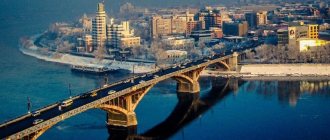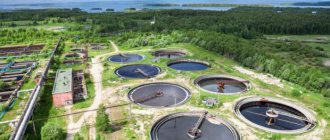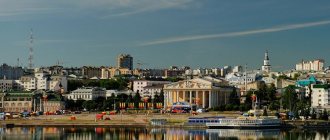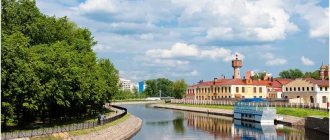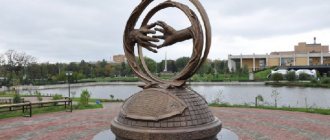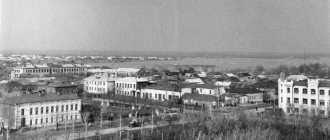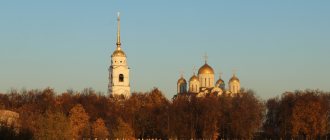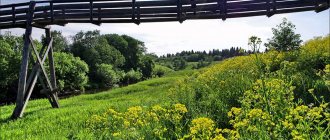Life in Bratsk is in full swing at any time of the year. Citizens do not sit at home, but go out for walks. Fortunately, there are plenty of interesting and picturesque places among the attractions of Bratsk.
As in other northern cities, on the facades of many houses there are bright drawings that occupy the entire space from the first to the last floor.
Often there is a combination of white facades and delicate tones in the decoration of balconies: pink, light green, blue, lemon.
In city squares there are beautiful fountains, sculptural compositions, and monuments made of various materials.
Grateful townspeople erected a monument to Honorary Citizen of Bratsk Ivan Ivanovich Naimushin, an honored builder who tragically died in a plane crash. Under his leadership, dozens of objects were built in the city.
In the evenings, some fountains are illuminated with dozens of colorful lanterns. On holidays, magnificent fireworks flash over the city.
City architecture
This is a northern city, so on the facade of almost any house you can find a colorful design that occupies a large area of several floors. Often, balconies on old houses are painted in soft pink, green, bluish and light yellow shades. The color of the facade will most often be white in a city like Bratsk. Attractions (photos below) include a large number of fountains and sculptures, architectural and historical monuments. So, what to see in the city of Bratsk? Read more about this.
Description
When you approach the memorial from the 30th Anniversary of Victory Boulevard, you see two majestic petals of flame frozen in concrete. On the sides, on the right and left, two concrete crescent-shaped steles almost adjoin them. Marble slabs are mounted on them. On each slab there is a surname and initials cast from copper: Pogodaevs, Moskovskys, Cheremnykhs, Khromovskys, Belomestnykhs, Vedernikovs, Oznobikhins, Khlystovs, Karnaukhovs, Bolsheshapovs, Rasputins, Parilovs, Terpugovs, Shamanskys - a total of 1585 surnames.
Bas-reliefs are carved inside the steles. On the outside we read the words: “We owe our life, our bright day to all of you who fell in battle with the enemy in 1941-1945. Glory to you, brave ones, glory to you, fearless ones, the memory of you among the people will not die.”
Sights of the city of Bratsk
In the city you can find a monument erected by residents grateful to Ivan Naimushin. This is an honored builder who died in a car accident. He supervises the construction of many houses in Bratsk.
In the evenings, fountains and lanterns of different colors glow in the city. On holidays, a large number of bright fireworks are always launched in Bratsk. Citizens, as well as visitors, can go out at this time to watch the fireworks from the observation deck. It offers a beautiful view of Bratsk, as well as the Angara. In the summer, people watch the regatta from here. On the right bank there is a karting center. If you are interested in this kind of pastime, then you can take a ride. Bratsk, whose attractions are actually varied, is famous for its hydroelectric power station. The hydroelectric power station site allows you to take wonderful photographs.
Energetik District
“Energetik” is the second largest urban district, in particular, it is a small and well-developed village (according to environmentalists, it is the most environmentally friendly in the city). The houses of the area are predominantly of Soviet construction, where the so-called “Khrushchev” buildings harmoniously coexist with multi-storey buildings. There is no private residential sector. There are also new buildings that miraculously appeared as a result of the “arrival” of Gazprom in the city. By the way, the offices of this Russian giant are also located in the Energetik district and are the most prestigious place to work in the city.
A distinctive feature of the area is its cozy green streets, squares and parks (with mighty pine trees). A children's park with attractions has also been preserved here (another similar park was once in the Center, but it was demolished).
In the area there is a good Palace of Culture, the Solnechny sports complex (with a swimming pool) and the Palace of Pioneers; there are many good sections and clubs for children (and all this is within walking distance).
Palace of Culture "Energetik"
The pride of the Energetik district (and the entire city as a whole) is the only university in the city - BRGU (which is considered the most prestigious city educational institution). Opposite BRSU there is a technical lyceum. The composition of teachers in these two educational institutions is quite strong. Graduates of the Lyceum easily enter higher educational institutions in Moscow and St. Petersburg.
The Energetik district is traditionally considered a residential area, an area favorable for people who support ideas about family values.
There are many kindergartens, schools, children's and adult hospitals in the area. The only “surprise” is a maternity hospital, which seems to exist, but in fact is absent, since it was moved to the central part of the city (due to the low birth rate in the Energetik area). But we must pay tribute - the ambulance arrives quickly (literally in a few minutes), you just have to say that the woman is pregnant.
Railway station "Padunskie rapids"
In the area there is a modern railway station - “Padunskie Porogy” (conveniently located within the city). The city airport is located not far from the Energetik district. City public transport runs frequently.
Interesting stuff! For a long time it was allowed to walk freely around the territory of the Bratsk hydroelectric power station, but due to possible terrorism, the territory was fenced off. But people (out of habit) still climb through the barbed wire and go to the parapets to enjoy the views of the reservoir.
It’s great that at any time of the year you can leave the house, take friends and children, sit on the shore of the “Brotherly Sea” or barbecue. You seem to be in the city, but also in nature.
It gets very cold in winter
Not far from the Energetik area there is the Horse Yard (a great place for a family holiday), where you can visit a mini-zoo, ride horses and eat in a cafe.
Another noteworthy place is Tenga (where horses are bred), 15 minutes from Energetik. People also traditionally come here in the fall to pick mushrooms.
On Tenge
Ethnographic Park
The attractions of Bratsk, photos with descriptions of which are given in this article, also include another tourist place, known outside the Irkutsk region. This complex attracts many thousands of visitors from all over the country every year. “Angarsk Village” is a complex of two sectors: Russian and Evenki. The latter are the indigenous people in this area. In the pine forest, experts reconstructed several religious buildings, traditional Evenki dwellings and utility buildings.
The Russian part of the ethnographic complex is represented by examples of ancient wooden architecture, which were brought from various parts of the region. All twenty-three buildings are quite interesting monuments. For example, the old tower of the fort, built in the mid-17th century, or the two-hundred-year-old St. Michael the Archangel Church cannot but evoke admiration, especially among those who love architecture and history.
However, they can be studied not only in the ethnographic complex. The local historical museum also serves for these purposes, which contains documentation, old press and photographs, and household items of the population of Bratsk. Many talented craftsmen lived and live in villages around the city who made a large number of interesting crafts. The Bratsk Art Museum exhibits them. In particular, these are exhibitions with wooden, stone and bone objects.
POGODAEV STREET, BRGTU, HOSPITAL COMPLEX
From Solnechnaya Street you can turn onto Pogodaeva Street. Immediately on the corner we will see the Industrial College. formerly a vocational school.
Next we get to Bratsk State University. This is one of the largest universities in Siberia. Address: Makarenko Street 40 phone: 7(3953) 32-53-08. I will list only the faculties:
- Faculty of Natural Sciences
- Humanitarian and pedagogical
- Engineering and construction
- Timber industry
- Mechanical
- economics and Management
- Energy and automation
- Without faculty
The university was founded in 1980. About 250 professors and associate professors teach there, and there are also academicians.
Next, behind the public garden, the hospital complex begins. It includes the clinic of City Hospital No. 2, a surgical department, traumatology, a gynecological department, an eye department, and a dental department separately in the 5th microdistrict. Address of city hospital No. 2: st. Pogodaeva 1, reception phone number 37-62-02. 106 doctors work there, opening hours are from 8 a.m. to 8 p.m., and the emergency room is open 24 hours a day.
A branch of the Irkutsk Regional Oncology Center is located here at Studencheskaya 1, telephone number 37-28-68. It provides diagnosis, treatment and rehabilitation of cancer.
Last year, the Bratsk Diagnostic Center opened at Pogodaeva 1-g, equipped with the latest science and technology. There is no such diagnostic equipment even in Irkutsk.
Doctors from Irkutsk provide consultations, both on referral from medical institutions across the poles, and for a fee to everyone. To receive an appointment, just register in your personal account on the diagnostic center website or make an appointment by calling 305-350.
Brotherhood Museum of the History of Political Exile
Many settlements in the north were previously used as places where the authorities of the Tsarist and Stalinist periods exiled political prisoners. The corresponding museum was opened more than twenty-five years ago. The exhibits told about the life of camp prisoners. However, several years ago, the exhibitions were disbanded and a historical exhibition relating to the events of the Eastern Siberian and Trans-Baikal regions was placed. Today, most of the objects on display in the museum are related to ethnography.
Showroom
Craftsmen from Bratsk and neighboring villages are famous for their ability to make crafts from various materials. The halls of the art museum display wonderful exhibits created by folk craftsmen in a traditional manner from wood, stone, and bone.
The museum hosts exhibitions of local artists, concerts, and literary evenings. Address: st. Komsomolskaya, 77.
Paleontological monuments
Bratsk, whose attractions are varied, is also known for the paleontological monument called “Grassing Elk”. Not far from the Angarskaya Village complex you can see a block of stone. At first glance, there is nothing interesting, but upon closer examination you can find an ancient drawing reminiscent of the outline of an elk. This rock art monument, according to scientists, dates back to the 8-5th century BC. The stone was found by the famous archaeologist Okladnikov, who explored Transbaikalia and Siberia.
Before the local rapids and the territory of Ushkaniya Island were flooded in the 70s of the last century, a section of the drawing with an elk was broken off from the rock and also moved to the ethnographic center. However, other examples of rock art were doomed to underwater oblivion. At that time, few people were interested in saving ancient monuments. But thanks to the preserved piece of rock with the image of an elk, residents of the region and the whole country will be able to remember for a long time about bygone eras, about which we know so little.
Weather and natural features
The Angara brings the water that fills the Bratsk Sea from Lake Baikal, so it is clean and quite cold. Closer to the power plant dam, the level of water pollution in the reservoir increases. The sharply continental climate of the Irkutsk region in the area of Lake Baikal and the Angara reservoirs is becoming milder, the amplitude of annual and daily temperatures is smaller here, winters are warmer and summers are cooler.
Weather on the Bratsk Sea for 10 and 14 days (in Bratsk)
Only in the hottest summer months does the reservoir warm up to a depth of 1 m to +20°C, and in winter the ice thickness can reach 1.25 m. The ice on the reservoir melts only by the beginning of May. Warm summer weather sets in at the beginning of June, and by mid-summer thermometers often show temperatures above +30°C.
© Ksenia Usova
By this time, the water in the shallow sandy bays reaches temperatures comfortable for swimming. Unfortunately, in the second half of summer there is a lot of rain, and in September the first frosts begin and the beach season ends. The short summer is not a hindrance for fishermen - after summer fishing comes the time of autumn pike hunting in the bays of the Bratsk Sea, and in December the ice fishing season begins.
